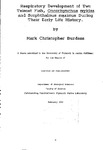Respiratory Development of Two Teleost Fish, Oncorhynchus mykiss and Scophthalmus maximus During Their Early Life History
| dc.contributor.author | Burdass, Mark Christopher | |
| dc.contributor.other | School of Biological and Marine Sciences | en_US |
| dc.date.accessioned | 2013-11-04T11:13:00Z | |
| dc.date.available | 2013-11-04T11:13:00Z | |
| dc.date.issued | 1993 | |
| dc.identifier | NOT AVAILABLE | en_US |
| dc.identifier.uri | http://hdl.handle.net/10026.1/2547 | |
| dc.description.abstract |
The respiratory development of two species of teleost, Oncorhynchus mykiss and Scophthalmus maximus was investigated to identify any possible periods of reduced respiratory fitness during early development. The two species were selected because of their different development strategies to allow any common factors in respiratory development to be identified. The study included determination of the respiratory oxygen demand and the critical oxygen tension (Pc) through early development for both species. Respiratory oxygen demand was measured as a routine rate (rVO2) with individual and weight specific values being determined. The main respiratory surface areas for both species were measured, this included the gills; body area; fin area and yolk-sac area in the case of O. mykiss. Changes in the rate of development was monitored by determining the mass and length specific development relationships. Significant changes in body fin and yolk-sac area occurred at approximately 70mg yolkless wet weight. for O. mykiss, gill area development was found to change at approximately 110mg. Similar changes in rate of fin and body area occurred for S. maximus at approximately 3.5mg wet weight, while gill development changed at 6.8mg. The change in epidermal thickness was measured during the development of S. maximus larvae and fry. During the larval development fin and body epithelium were significantly different up to 4.6mg wet weight with fin area being significantly thinner. Epidermal thickness increased from 2µm to 23µm over the 35 day period of monitoring. The degree of vascularisation of the yolk-sac of O. mykiss larvae was measured and found to remain relatively constant at approximately 41%. up to 70mg wet weight before declining. Mean minimum diffusion distances increased from approximately 13. 5µm to 35µm over the life-span of the yolk-sac. The change in erythrocyte type was also monitored during this period and found to decline in a similar manner to yolk-sac area. O. mykiss larvae reared under hypoxic conditions showed reductions in growth towards the end of the period of endogenous feeding, as well as increased development of gill area and increased levels of vascularisation (up to 10%) of the yolk-sac. compared to normoxic reared larvae. A study of the effects of removal of the respiratory pigment at different stages of development was also undertaken. This allowed the significance of haemoglobin during development of both species of fish to be estimated. Respiratory fitness was inhibited in both species with reductions of up to 2mg02/l in the Pc for O. mykiss, and 2. 5mg02/l for S. maximus. However, S. maximus showed a high level of dependence on haemoglobin for gaseous exchange during a short phase of development from 9.5 to 15mg wet weight were removal of haemoglobin caused 100% mortality in treated fish. Overall the study showed the low level of respiratory flexibility of S. maximus when compared to O. mykiss, especially during early development. This must have significant importance for the intensive mass culture of the larvae of this species. The important role cutaneous respiration plays during the early development of both species was also highlighted. | en_US |
| dc.description.sponsorship | Plymouth Marine Laboratory | en_US |
| dc.language.iso | en | en_US |
| dc.publisher | University of Plymouth | en_US |
| dc.title | Respiratory Development of Two Teleost Fish, Oncorhynchus mykiss and Scophthalmus maximus During Their Early Life History | en_US |
| dc.type | Thesis | |
| plymouth.version | Full version: final and full version as approved by the examiners at the time of the award of your degree | en_US |
| dc.identifier.doi | http://dx.doi.org/10.24382/3959 | |
| dc.identifier.doi | http://dx.doi.org/10.24382/3959 |
Files in this item
This item appears in the following Collection(s)
-
01 Research Theses Main Collection
Research Theses Main


